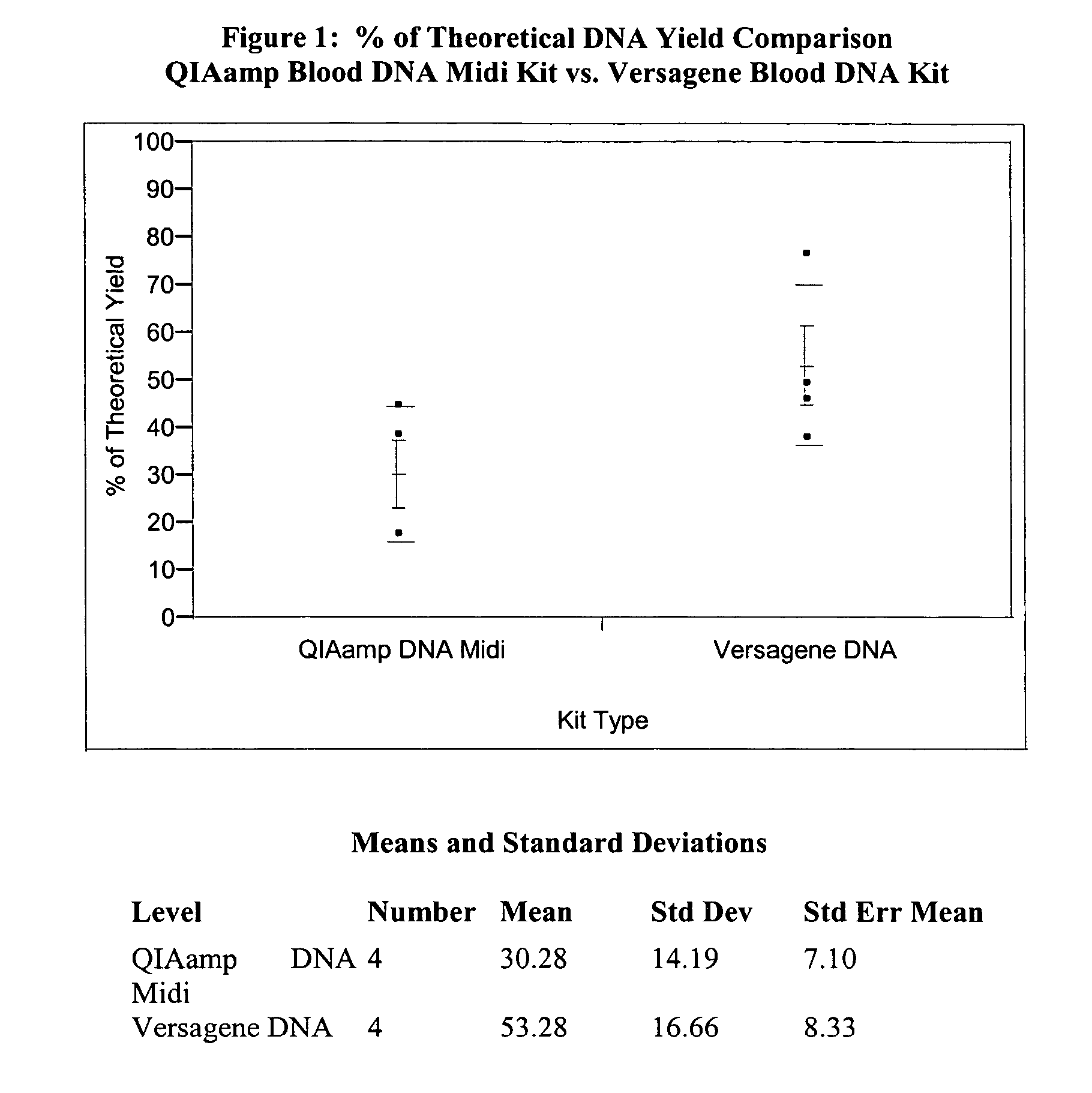Compositions and methods for using a solid support to purify DNA
a technology of solid support and dna, which is applied in the direction of nucleic acid reduction, microorganisms, organic chemistry, etc., can solve the problems of hazardous reagents, many steps in conventional liquid phase and solid phase purification strategies, etc., and achieve the effect of increasing the amount of dgme and increasing the solubility of other components
- Summary
- Abstract
- Description
- Claims
- Application Information
AI Technical Summary
Benefits of technology
Problems solved by technology
Method used
Image
Examples
example 1
[0087] In order to produce the best quality solid phase DNA purification product, the product must function exceptionally well in several respects. The solid phase DNA purification product must effectively isolate a pure DNA sample from a variety of sample types and result in the highest possible yields of DNA. It must be user friendly, meaning the steps must not be too onerous, and the components must not be toxic and can be disposed of easily. Further, the product must be economical for the user. Therefore, finding cost effective components for the solutions was essential. Table 1 shows the cost for each of the salts evaluated herein.
TABLE 1CostSaltAmount (grams)Cost ($)BeCl225600.00CaCl2500105.00CsCl500340.00KCl50030.00LiBr50065.00LiCl50060.00LiF50400.00LiI250330.00MgCl250050.00NaCl50024.00NH4Cl50022.00
[0088] Although the lithium salts work well for the methods of the present invention, the lithium salts LiF and LiI are expensive, and additionally, LiF is quite ha...
example 2
Solubility and Heat of Solution Data for Chloride Salts and Compared to LiCl and LiBr Salts for Solid Phase DNA Purification Procedure
[0089] The solubility and performance of several chloride salts was examined and compared to two lithium salts, lithium chloride and lithium bromide. The DNA Lysing Solution was prepared using other chloride salts, in order to examine maximum solubility obtainable in both the buffer and detergent based DNA Lysing Solution. Table 2 shows the approximate maximum solubility as measured in this work and compares it to tabulated solubility data extrapolated to 20° C., as well as tabulated heat of solution data as obtained from the Handbook of Chemistry and Physics (62nd edition, CRC Press, Boca Raton, Fla.).
[0090] The solubility of most of the chloride salts studied in the Lysing Solution, were comparable to the lithium chloride and bromide salts at a concentration of 4 M, except for those of potassium chloride and ammonium chloride. The expected solubil...
example 3
Evaluation of Detergents for DNA Purification
[0092] Much time and effort was spent screening detergents that would adequately lyse cells and also stay soluble in the DNA Lysing Solution of the present invention. The Tween, Triton, Tergitol, Nonidet and Igepal family of detergents were examined along with a number of surfactant compounds.
[0093] It was discovered that many of these detergent formulations, when mixed with the other ingredients of the DNA Lysing Solution, saponified or degraded over time and precipitated out of solution. For example, this occurred with 10% Tween-20 (polyoxylene sorbitan monolaurate). Similar performance was found using an equal mixture of Triton X-100 (t-octylphenoxy polyethoxyethanol) and Tween-20, though this mixture was stable for longer periods of time. This mixture, however, eventually saponified and separated. DGME (diethylene glycol monoethyl ether) was chosen for testing as a surfactant to help solubilize the salt and detergent combinations. A...
PUM
| Property | Measurement | Unit |
|---|---|---|
| Fraction | aaaaa | aaaaa |
| Fraction | aaaaa | aaaaa |
| Fraction | aaaaa | aaaaa |
Abstract
Description
Claims
Application Information
 Login to View More
Login to View More - R&D
- Intellectual Property
- Life Sciences
- Materials
- Tech Scout
- Unparalleled Data Quality
- Higher Quality Content
- 60% Fewer Hallucinations
Browse by: Latest US Patents, China's latest patents, Technical Efficacy Thesaurus, Application Domain, Technology Topic, Popular Technical Reports.
© 2025 PatSnap. All rights reserved.Legal|Privacy policy|Modern Slavery Act Transparency Statement|Sitemap|About US| Contact US: help@patsnap.com


